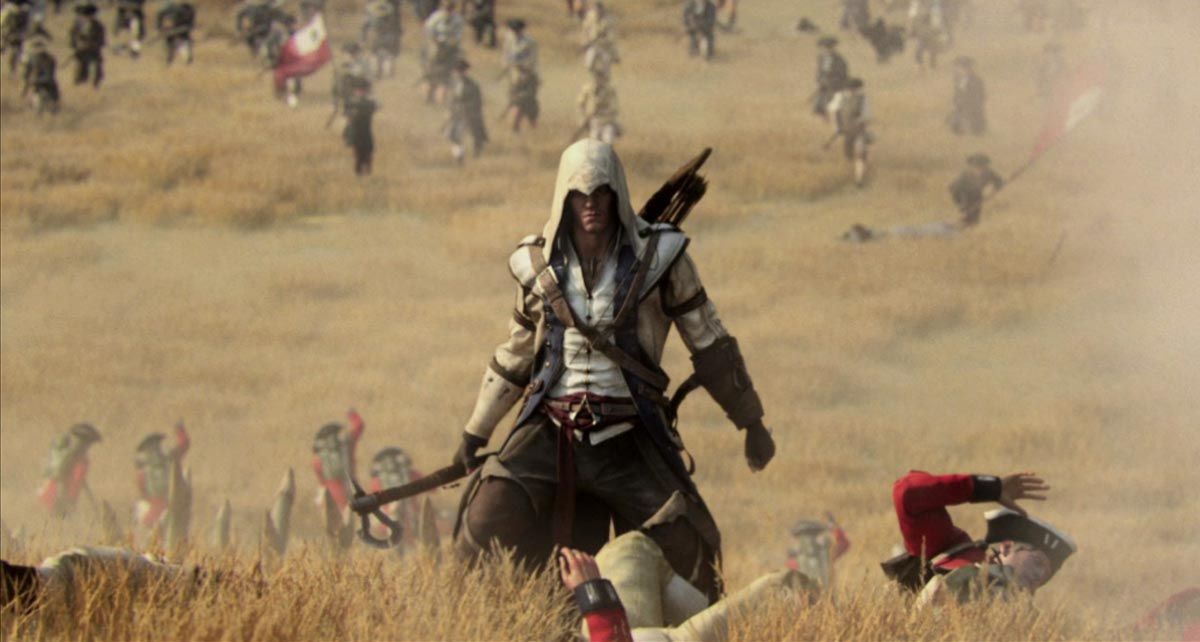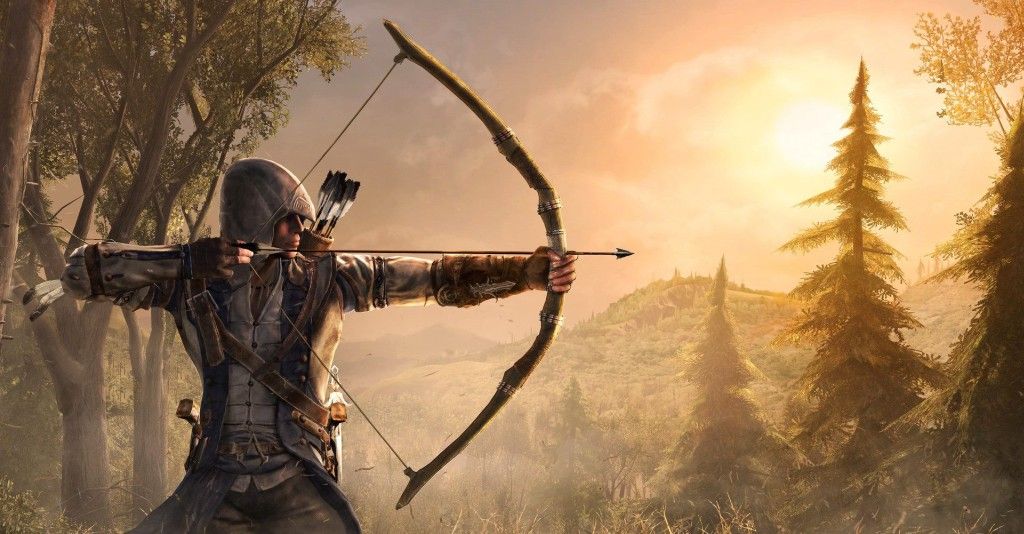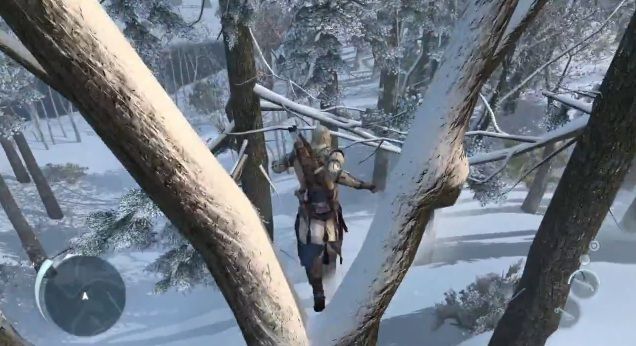This post has not been edited by the GamesBeat staff. Opinions by GamesBeat community writers do not necessarily reflect those of the staff.

Assassin's Creed pens a history rife with conspiracy illuminated by Templars and Assassins. It makes players part of a mosaic of pivotal moments that decided the fates of nations with a clever blend of stealth, parkour, and philosophical challenges shaking the foundations of its own characters. For five years, Ubisoft's narrative has spanned millennia of events pointing straight to December 21, 2012.
Unfortunately, AC3 feels as if it were shoved through the door to make it out before the end of the world alongside its protagonists, tipping over the ink bottle on the way out all over its pages.
This time, it's off to the American Revolution with Connor, a Native American who becomes the newest Assassin to don the white hood against the machinations of the Templars. He'll bloody his knives with Redcoats and Patriots both before he's done while rubbing elbows with nearly everyone from Samuel Adams to ol' George Washington himself, most of whom show up to give the lad some advice on what to do next.
But Connor is only one side to this coin – Desmond Miles is the other half and arguably, the real hero of the story. It's through Desmond's sessions in a machine called the Animus that he can relive Connor's life, and that of other ancestors, to find the lost knowledge needed to save the present.
Picking up right after the events of Revelations, the story does an okay job in bringing the player up to speed right before dumping them at the doorstep of this latest mystery. But more on the story in a bit, because the first of those ink spots start showing up almost immediately after a stirring start at a theater play.
When the captain of the ship taking me over to the New World spoke without his lips moving during a cinematic, I chalked it up to that rare kind of glitch that could be glossed over. Maybe the guy was psychic. But things only got worse from there.

Replacing the crossbow is this sucker for silent kills. Or quick shots if you're caught having
to reload your flintlocks.
Rebecca Crane, the tech who helps keep things running, updated the Animus in the game's clever way of making what is seen in the machine something of a work in progress. It's also, if you want to go so far, something that explains just how broken things seem. The bad news is that whatever Rebecca did, she should have left well enough alone.
Connor was a tough guy, but even I was amazed after punching a man through the map. I'd also see enemies treat a dead body as if it were killed by Longshanks in Braveheart, continue to deal with horses that stop on a dime when lumps of rock no higher than Connor's knees are in their way, follow icons to conversations that aren't there, or watch NPCs pop in from thin air before gently landing on the ground.
Water is still lethal to everyone except the player. No one has bothered to learn how to swim making it weird to see soldiers tumble into the drink and just sink to the bottom, though it could be shorthand for Connor's superior ability to stay above the waves saving players the trouble of watching enemies flail about, but that might be pushing things.
Even the interface felt clunky. Tasks have been split to more places on the controller, and not always for the better, such as with the map. Before, you could use the left analog stick to glide across it and the right stick to zoom in and out. Now the triggers are used for zooming, the left stick and d-pad are used to scroll down a smaller menu list on the side, and the right stick is used to glide over the map. It takes a little getting used to, but I'm not sure what was so wrong about the last interface that made it necessary to bloat this one.
The same goes for the weapon and consumable options. Instead of the ring menu that made it easy to pick whatever you wanted on the fly, these get a splash of remodeled graphics and a linear approach to picking through what you want instead. Add in a pause for every time the game seems to need to load this newfangled gloss and having to move up and down instead of in 360° of freedom, and it just feels like a lot of flash added for little real improvement. This wouldn't be so annoying if I didn't often have to use it to do what I wanted through thirty plus hours of play.
On the plus side, climbing feels slightly improved as an in-game email doubling as a readme.txt file for what was fixed (probably a first for gaming) explains. Now, I no longer needed to press a button in conjunction with a trigger button to initiate Connor's parkour over stuff which made soaring through the trees of its new forests a bit easier after getting over the slight curve.

Gliding through the trees took a little getting used to at the beginning because of how
new it is, but once I had the basics down, it's pretty awesome.
Now, one just needs to hold down the R1 by itself to keep him moving despite a few historically chronic issues still cropping up. Sometimes he'll still get “stuck” atop surfaces forcing me to have him parkour off of them instead of simply dropping or stepping down. Connor may sometimes throw his hands up against thin air as if he were flush with a wall when only a low lying object no higher than his ankles may be in the way. After five years of this, the old stuff still has a way of creeping in.
But hiding around corners has also buggered the system when I least wanted it to. It's a new thing for the series and when it works, it's a great technique that feels as if it should have been there since Altair started hitting Templars in the Holy Land. By clinging to corners, players can lure enemies in for a quick and covert kill. Unfortunately, sometimes when I'm running along want just want to climb a wall but find myself too near a corner, it gets in the way more often than I would have liked.
Even so, in another mission that required me to stay incognito, I had somehow managed to assassinate an entire section of a camp without a problem simply by clinging to a corner. Even when enemies found a pile of dead bodies and wandered past me, for whatever reason, they never saw me nor chose to raise the alarm as long as I stuck to that corner.
Combat remains much as it is has been in previous iterations with counter-move kills, smoke bombs, daggers, knives, and swords unleashing animated death on whoever Connor is leveled towards. The emphasis on firearms does add a new twist with pistol and rifle kills. Also handy is the ability to use other enemies as human shields to absorb musket fire. But if you've been with the series since Altair's debut, it's still as familiar as it has always been in getting the job done, though with an improved engine under the hood, the game can now throw a lot more bad guys into the mix.
Fighting also takes place on the waves with the kind of ship-to-ship action that makes me think of how Sid Meier's Pirates could be like in Ubisoft's hands. Its beautiful, arcade-like action sticks to being fun as opposed to accurate with your ship carousing around the waves like a giant speedboat white rattling off a broadside at enemies that burst into clouds of flaming splinters. Even here, you have options – shatter the enemy's sails or load up grape shot turning your cannon into giant shredding shotguns? As long as you have the money, you can buy as many upgrades as you need to turn Connor's boat into a battleship.
Colonial America looks fantastic in either snow or summer. Tracks are left in snow drifts and rain spatters everything with wet sheen when it comes down, though a few rough edges still mar an amazingly ambitious recreation. Horsedrawn carts rumble along cobblestone streets running over and dragging indestructible NPCs along on occasion and a few lean against thin air instead of the walls they're supposed to. That said, on the whole, Ubisoft's artists are still among the best in the world for bringing so much of this chapter of the past to vivid life despite what the glitches do to smear it.

Connor is just as brutal as Ezio and Altair ever were. Here, he's force feeding a rifle
to a mercenary. Which he does often.
On the other hand, Connor's story lacks the kind of punch that the previous ones had delivered. After the thrilling start, things petered out thanks to a number of questionable situations that made the Assassin's newest member seem like a complete idiot. A lot of that is Ezio's fault for being such a tough act to follow leaving the rest to situations that just seem to jump out at the player without any real build-up in order to force in events. A lot of that left me with the impression that parts of the game were simply rushed — all the way up through to the ending.
Dialogue-wise, however, the game continues the series' tradition of delivering sharply worded screeds that mix together enough black and white perspectives to start seeing grey making me, if not Connor, question whether certain things absolutely had to go down the way they did. New “Homestead” missions build up a community and unlock arsenal upgrades while fleshing out NPCs whose stories bring a refreshing break from Connor's murder-spree as well as a reason to sell off or use all of those pelts and teeth that collected from hunting.
Multiplayer continues to be an either you like it or not piece of the series. It's fun playing hide-and-seek in the typical modes offered up such as deathmatch, team deathmatch, domination, assassination, or wanted. Wolfpack injects a nice co-op mode for players to work together to kill AI targets to move up “sequences” in Assassin's Creed's take on horde. And it also provides a strong tutorial outlining the basics which is a lot more than can be said for the actual single-player campaign that assumes veterancy with its mechanics.
That's what AC3 feels geared towards – series fans who have a lot invested into its story and its world – because there's really little else that assumes otherwise. The manual is a waste of time, there's much less emphasis on practicing and training skills via tutorials as there was in the AC2 series, and we're left to assume a great many things about Connor given his relatively brief introduction. The success of AC2 has set the bar high, perhaps too high, for Connor's finer points to be as distilled through trial and error as many times as Ezio's has through numerous examples.

Boston and New York are crammed with humanity thanks to the improved engine. I just wish
there was more that could be done with these set pieces, but at least you have a
Homestead to look over.
And it shows, not only in his character, but in how others simply pass through the night like Benjamin Franklin. Anyone who remembers Leonardo da Vinci's participation in AC3 might wonder why Franklin hasn't received the same thing other than start you off on a collection mission for almanac pages.
But the miserable state in which what closes out a major arc for the series is what is more disappointing than anything else. Assassin's Creed's titles all have their own issues, but AC3 simply feels saturated in comparison to its predecessors, so in-your-face are its flaws some of which had also forced me to repeat two or three missions just to “reboot” the objectives so that they would work. It's simply surprising to see the game released like this at all.
Yet when it's on the ball as it is on the salty waves, the artistry of its world, and the moments when the direction of certain poignant pieces make one forget for a moment that it's only a game, the stifled potential bucks up against the scarred surface. As someone who has been with the series since the first game, though, I can't help but think of how it could have catapulted players the way that Altair's or Ezio's stories have.
AC3 can occasionally glide through the trees like an Assassin. I only wish it didn't have as much trouble on the landings.
